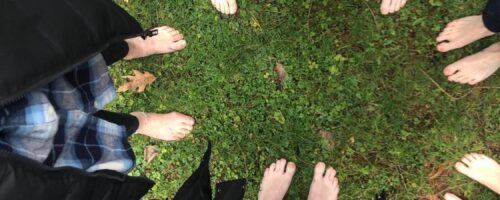
{49.265538213846504,-123.25692693809816}
February 15, 2022
We are inspired by Beavington (2021) as they speak of learning with and through the body as a “joyful, relational, and deeply engaging experience.” We keep this in mind as we decide to expand our wonders about how to experience our inquiry place by walking together with our bare feet. At once, we sit down, each on an individual rock or stump, reach down and tug off our shoes, pull down our socks until our wiggly toes are exposed to the crisp cold air. There is a pause and the sound of deep breathes before we begin to move. Sheana starts walking first and tells us how her feet are instantly being met with a variety of sensations. The rest of us carefully place our feet down onto the uneven forest ground and slowly walk to meet Sheana on the prickly dew-drop-covered grass.
Vanessa felt uncomfortable at first as it took some time for her toes to adjust to the drastic change in temperature. Once she settled into the experience she tried to focus her attention on each speck interacting with her body. This reminded her of practices of grounding her body where you try and be intune with every element of one’s body. “For many people, walking through a temperate rainforest, or alongside a stream, elicits a sense of the interrelation of all beings (what ecology science quantifies), as well as a sense of the sacred” (Beavington, 2021, p.172)
Keira enjoyed experiencing something new and pushing herself outside of her comfort zone. Walking barefoot also made Keira notice the amount of human-litter in our inquiry area, as she felt nervous about where she was stepping and this made her reflect on this element we had previously missed while inquiring.
Sheana felt more directly connected to the land we were visiting and our inquiry altogether. “Direct sensorial experience offers not only active and experiential pedagogy, but also a spiritual attunement with the natural world.” (Beavington, 2021, p.172)
Emma had a unique experience that she was not used to, especially being in winter- typically she only walks barefoot in the summer time so this was a big change.
Allison felt cold and the feeling was uncomfortable as it was something new to her, especially in colder weather. She noticed the softness of the ground more than when we are wearing shoes. “Without shoes, you are more bodily aware, more mindful of each step, led more by your senses and less by habit. If the body is a thinking being, then every pore, hair, and sensory neuron— such as the 200,000 nerve endings on the sole of each foot—can be made available for clarity of thought. To think with our feet is to think with the earth.” (Beavington, 2021, p.173)
Jenn had an immediate feeling of coldness on her feet and it put a shiver all the way through her body. There was an immense sensation on her feet to move from the bumpy cement to prickly pine needles, and the softness of grass. It felt unusual because it is not a season she would typically walk barefoot in. “This feels like a simple exercise [walking barefoot]. Perhaps, much like walking a forest path in silence, the simplicity is what allows for something profound. The primacy of experience allows for holding our attention to touching the earth and to the earth touching us. While the pavement does not respond to my steps, the earth reciprocates like well-fitted orthotics, with texture, flex and counsel.” (Beavington, 2021, p.173)
Photo taken by Sheana

